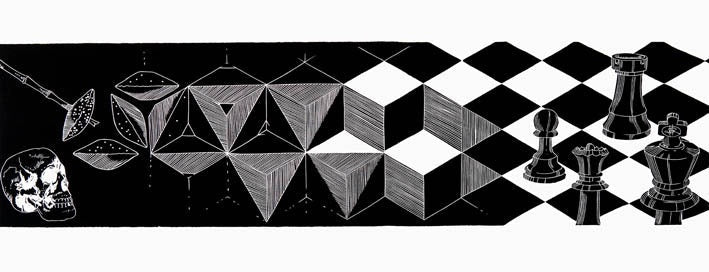Brian Robinson
BRIAN ROBINSON | 'Dawn Raid Strategy' | Linocut print
BRIAN ROBINSON | 'Dawn Raid Strategy' | Linocut print
Couldn't load pickup availability
Linocut printed in black ink from one block
Image size: 200mm x 785mm
Artist: Brian Robinson
Region: Waiben (Thursday Island), Torres Strait
Language: Kala Lagaw Ya
Born: 1973
Artwork story: An Island warrior ready for battle, with his bow and arrows, stone club, war headdress and body decorations, must have been an awesome sight; and during the fight, a formidable foe. He was a fierce headhunter – his collection of heads showed the measure of his prowess in battle. Through these heads, he believed he would possess the strength of his enemies. Warfare in the Torres Strait resulted in ‘pay back’, a cycle of revenge killings which was the basis of much inter-island warfare. Coupled with this was a warrior code, which glorified the killing of foreigners and the taking of heads. Most deaths, except those from planned violence, were believed to result from sorcery. Having identified a sorcerer, kinsmen of a deceased person would launch an attack on his community, sparing neither women, nor children, nor the elderly, and taking the heads of all. It was not uncommon for sneak attacks to be made on women in gardens or lone fishermen on reefs. Dawn attacks were favoured as it was assumed that sleeping communities were off guard.
Catalogue ID: BRRO042
Artist bio: Brian Robinson is a multi-skilled contemporary artist, whose practice includes painting, printmaking, sculpture and design. The graphic style in his practice combines his Torres Strait Islander heritage with a strong passion for experimentation, both in theoretical approach and medium, as well as a crossing of the boundaries between reality and fantasy. The results combine styles as diverse as graffiti art through to intricate relief carvings and construction sculpture echoing images of Torres Strait cultural motifs, objects and activity. Robinson’s art reflects the tropical marine environment surrounding Waiben (Thursday Island) and the inhabitants of that environment. It is an essential part of his life and culture, imbued with the customs, traditions and lifestyles of Torres Strait Island people. The animals from ancestral stories and their presence today are an integral feature of Robinson’s work.
Robinson’s sculptural practice stems from the discipline of constructivism, a style of sculpture that emerged in the early twentieth century based on carefully structured modules that allow for intricate, and in some cases infinite, patterns of repetition, sometimes used to create limitless, basically planar, screen-like formations, and sometimes employed to make more multi-dimensional structures. Surface treatments for Robinson’s sculptural works have included coconut-leaf matting, split bamboo, cowrie shells, feathers, lace, photographic prints and linocuts on paper.
His approach to printmaking in both etching and linocut is linear in composition and appearance. These prints illustrate Robinson’s depth of connection to heritage paired with his aesthetic and intellectual exploration of Western art iconography in relation and connection to Torres Strait culture.
Robinson's work has contributed significantly to the environs of Cairns, his home for two decades, through a number of major public art installations including the signature five stainless steel woven fish sculptures and fountain installed on the Cairns Esplanade in 2003. His work has been widely collected both privately and through major institutions both in Australia and overseas. From September 2010 Robinson undertook a 12-month Artist in Residence at Djumbunji Press KickArts Fine Art Printmaking Studio located in Cairns, developing an impressive body of new works in etching and linocut.
BRIAN ROBINSON | 'Dawn Raid Strategy' | 2011 | Linocut print | 40 (h) x 78.5 cm | Edition of 30


